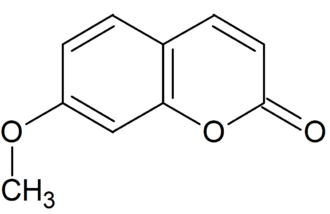Methoxycoumarin Dyes
The structure of methoxycoumarin is the substitution of the seven position of coumarin with methoxy. Methoxycoumarin is a natural chemical compound. Chemically, it can be considered a methoxy derivative of coumarin or a methyl derivative of umbelliferone. Herniarin is found in Herniaria glabra, Ayapana triplinervis and in species of the genus Prunus.
 Figure 1. Chemical structure of Methoxycoumarin.
Figure 1. Chemical structure of Methoxycoumarin.
Coumarin compounds are an important component of fluorescent dyes. They can be used in the fields of fluorescent dyes, laser dyes, and optoelectronic materials. They are a class of benzopyran structures with high fluorescence quantum yield (φf). Stokes with large displacement (Stokes, Chinese translation Stokes, unit of dynamic viscosity, equal to cm/s), compounds with adjustable photophysics and photochemistry, and good light stability, have become the preferred fluorescent group in the molecular design of fluorescent sensors. From the perspective of molecular structure, the coumarin compound inhibits the rotation of the double bond through the lactone structure and improves the light stability. Studies on the relationship between the structure and fluorescence properties of coumarin compounds have shown that the fluorescence of coumarin compounds is related to the intramolecular charge transfer from the 7-position electron-donor group to the hydroxyl group in the lactone bond in the coumarin ring. Moreover, various functions can be achieved by slightly changing the donor-acceptor portion of the substituent on the coumarin parent. Changes in the properties of the 7-position electron donor group and the 3- and 4-position electron withdrawing group on the coumarin molecular structure can cause the coumarin compound to change from yellow, red to blue-green and different fluorescent properties. The function of coumarins depends to a large extent on the nature of the substituents at each position of the coumarin ring, especially the effects of the substituents at the 3- and 4-positions are more pronounced. In 1868, Perkin first used salicylaldehyde and acetic anhydride as raw materials. Cycloaddition in the presence of sodium acetate yielded coumarin. This method has been the main method for the industrial production of coumarin. The 3-aryl substituted coumarin is obtained by adding salicylaldehyde and benzoic acid derivatives as raw materials and heating and cycloaddition under basic conditions such as pyridine or triethylamine. Coumarin and its derivatives are one of the first fluorescent dyes found in plants. It is widely distributed in many plants. So far, more than 100 natural coumarin compounds have been discovered. Later, heterocyclic compounds such as quinoxaline derivatives, anthranilic acid amide derivatives, xanthene derivatives, cyclic dextrin derivatives, and pyrrole derivatives were discovered successively. Good fluorescent material. Therefore, many natural and synthetic coumarin derivatives are used in fluorescent whitening agents, laser dyes, and fluorescent dyes.
Reference:
- Du, Lupei.; et al. Rational design of a fluorescent hydrogen peroxide probe based on the umbelliferone fluorophore. Tetrahedron Letters. 2008, 49 (19): 3045–3048.
Resources

- Hoechst Dyes: Definition, Structure, Mechanism and Applications
- Mastering the Spectrum: A Comprehensive Guide to Cy3 and Cy5 Dyes
- Fluorescent Probes: Definition, Structure, Types and Application
- Fluorescent Dyes: Definition, Mechanism, Types and Application
- Coumarin Dyes: Definition, Structure, Benefits, Synthesis and Uses
- BODIPY Dyes: Definition, Structure, Synthesis and Uses
- Cyanine Dyes: Definition, Structure, Types and Uses
- Fluorescein Dyes: Definition, Structure, Synthesis and Uses
- Rhodamine Dyes: Definition, Structure, Uses, Excitation and Emission
- Unlocking the Power of Fluorescence Imaging: A Comprehensive Guide
- Cell Imaging: Definitions, Systems, Protocols, Dyes, and Applications
- Lipid Staining: Definition, Principles, Methods, Dyes, and Uses
- Flow Cytometry: Definition, Principles, Protocols, Dyes, and Uses
- Nucleic Acid Staining: Definition, Principles, Dyes, Procedures, and Uses
- DNA Staining: Definition, Procedures, Benefits, Dyes and Uses
- Cell Staining: Definition, Principles, Protocols, Dyes, and Uses
- Ion Imaging: Definition, Principles, Benefits, Dyes, and Uses
- Fluorescent Labeling: Definition, Principles, Types and Applications
Online Inquiry


